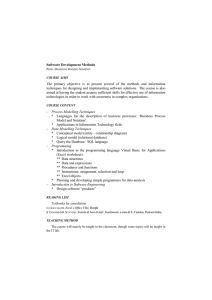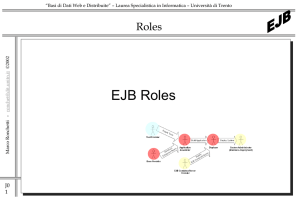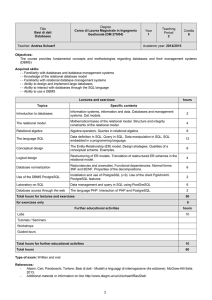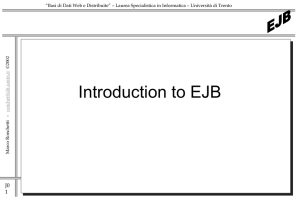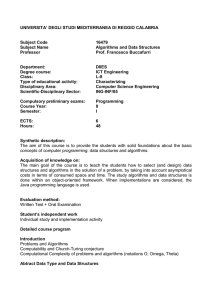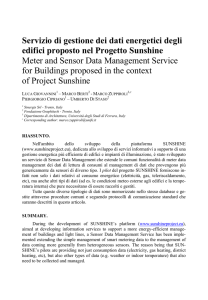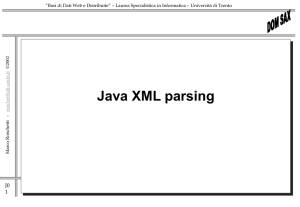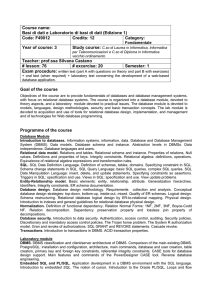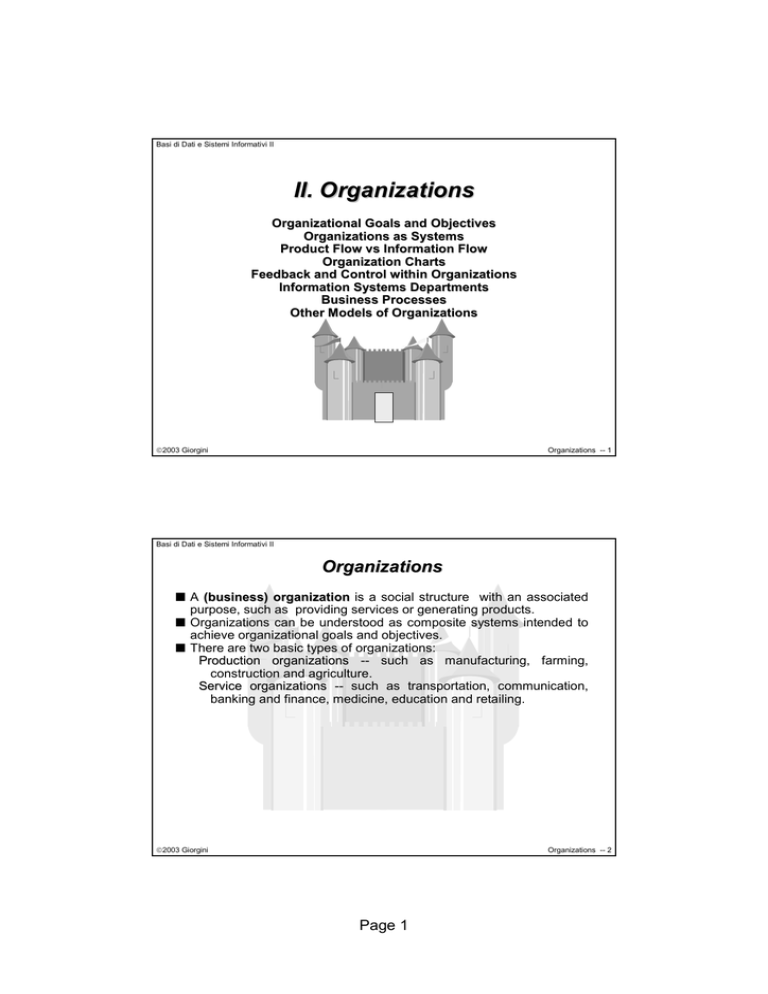
Basi di Dati e Sistemi Informativi II
II. Organizations
Organizational Goals and Objectives
Organizations as Systems
Product Flow vs Information Flow
Organization Charts
Feedback and Control within Organizations
Information Systems Departments
Business Processes
Other Models of Organizations
2003 Giorgini
Organizations -- 1
Basi di Dati e Sistemi Informativi II
Organizations
Q A (business) organization is a social structure with an associated
purpose, such as providing services or generating products.
Q Organizations can be understood as composite systems intended to
achieve organizational goals and objectives.
Q There are two basic types of organizations:
Production organizations -- such as manufacturing, farming,
construction and agriculture.
Service organizations -- such as transportation, communication,
banking and finance, medicine, education and retailing.
2003 Giorgini
Organizations -- 2
Page 1
Basi di Dati e Sistemi Informativi II
Organizations as Systems
customers
billing
employees
paying
collection
sales
vendors
purchasing
production
distribution
inventory
receiving
Person or
organization
Subsystem
2003 Giorgini
product or document flow
Organizations -- 3
Basi di Dati e Sistemi Informativi II
Product Flow vs Information Flow
customers
billing
collection
sales
finished goods
employees
production
distribution
inventory
vendors
paying
purchasing
receiving
raw materials
Product flow
Information flow
2003 Giorgini
Organizations -- 4
Page 2
Basi di Dati e Sistemi Informativi II
Information Flow Through Documents
customers
This is the type of
information flow
a systems analyst
has to understand
to perform her task!
sales
order
customer
invoice
billing
sales
customer
payment
customer
payment
notice
collection
sales
notice
2003 Giorgini
Organizations -- 5
Basi di Dati e Sistemi Informativi II
The Organization Chart
The organization chart defines areas of responsibility and lines of
authority within an organization.
Superior
authority
Subordinate
responsibility
Subordinate
Subordinate
Q Strictly hierarchical organizations do not perform as well as
organizations that are based on other organizational structures.
Q Heterarchical relationships "cut across" departments to make
decisions more democratic, and functioning of the organization
less bureaucratic
These charts are essential for systems analysis!
2003 Giorgini
Organizations -- 6
Page 3
Basi di Dati e Sistemi Informativi II
Levels of Authority
Top management -- establishes
goals, does long-range planning,
determines new market and
product developments, decides on
mergers and acquisitions.
Q Middle management -- sets
objectives, allocates and controls
resources, does planning and
measures performance
management
-Q Lower
supervises day-to-day operations,
takes corrective action when
necessary.
Q Operational level -performs
day-to-day operations
Q
top
management
strategic
middle
management
tactical
lower
management
supervisory
operational
functional
2003 Giorgini
Organizations -- 7
Basi di Dati e Sistemi Informativi II
Vertical vs Horizontal Integration
top
management
strategic
middle
management
tactical
admin rt
o
supp
financial
services
supervisory
product
developmen
t
operational
mar
keti
ng
lower
management
functional
Information systems play a crucial role
in this integration
2003 Giorgini
Organizations -- 8
Page 4
Basi di Dati e Sistemi Informativi II
General Systems Theory
A systems exists within an environment.
A system is separated from its environment by some sort of a
boundary
Systems have inputs and outputs. They receive inputs from their
environment, and send outputs into their environment.
Systems have interfaces. An interface allows communication
between two systems.
A system may have sub-systems. A sub-system is also a system,
and may have further sub-systems of its own.
2003 Giorgini
Organizations -- 9
Basi di Dati e Sistemi Informativi II
System Parts
2003 Giorgini
Organizations -- 10
Page 5
Basi di Dati e Sistemi Informativi II
Feedback
Aims to maintain the system´s equilibrium by opposing deviations
from some norm.
2003 Giorgini
Organizations -- 11
Basi di Dati e Sistemi Informativi II
Organizational Feedback and Control
Organizational systems need feedback mechanisms too, to ensure
that their intended goals are met.
goals
revised goals
revisions
outputs
system
corrective
action
comparison
2003 Giorgini
Organizations -- 12
I f
ti
t
l
Page 6
i
t
t
l
Basi di Dati e Sistemi Informativi II
Organizational Feedback Example
Produce+sell
1.1M iMacs
Produce+sell
1M iMacs
revisions
Change
Production
targets
Produced 0.9M
Sold 1.1M
system
Increase
production
comparison
Information systems play an important role
in the provision of feedback
2003 Giorgini
Organizations -- 13
Basi di Dati e Sistemi Informativi II
Feedforward
Relies on sampling system´s inputs rather than its outputs.
Positive feedback: works reinforcing deviations instead of
opposing them and therefore tends to increase movements
away from the equilibrium.
For example, consider seasonal markets (such as the
Christmas toy business): manufacturing is adjusted to suit the
level of orders (input) rather then sales (output.)
2003 Giorgini
Organizations -- 14
Page 7
Basi di Dati e Sistemi Informativi II
Information Needs for Organizational
Integration, Feedback and Control
Managt.
Managt. Level Information Use
Information Requirements
Top
Management
Goal setting,
long-term plan.
strategy
return to invest.
External info: new markets,
competitors, govt.,
Internal info: financial reports,
long-term trends, what-if
info,...
Middle
Management
objectives def.
medium-range
planning
tactics
Internal info, problem reports,
short-term trends,
Lower
Management
obj. attainment
short-term plan.
supervision
Internal info, recent historical
data, details on operations,
exceptions report
2003 Giorgini
Organizations -- 15
Basi di Dati e Sistemi Informativi II
The Structure of Information Services
Departments within an Organization
Chief Information Officer (CIO)
Director, Information Services
Manager,
Systems
Department
Database
Admin
Data
Admin
Manager,
Telecom
Data
Analysis
2003 Giorgini
Manager,
Computer
Operations
Network
Analysis
Organizations -- 16
Page 8
Basi di Dati e Sistemi Informativi II
Information Services Components
Q Operations Centre: Runs computer and communications units;
consists of systems programmers, engineers, operators, data
entry personnel, couriers; responsible for systems' operation and
support
Q Systems Department: Interfaces with
the rest of the
organization and determines what systems are to be built;
consists of systems analysts, application programmers,
documentation personnel, database designers; responsible for
new application development
Q Data Administration: Responsible for organizational databases
and database design
Q Telecommunications Centre: Serves the telecommunication
and (micro)computer needs of the organization. Buys, evaluates
and installs microcomputers,software and in-house network
services. May also handle document storage and retrieval;
responsible for infrastructure
2003 Giorgini
Organizations -- 17
Basi di Dati e Sistemi Informativi II
The Structure of IS Departments:
Centralized, Decentralized or Outsourced?
Q Centralized departments mean that there is only one hardware
facility, one systems management group, one information systems
specialist group
centralization, in general,
doesn't make much sense today
Q Decentralized departments means that each organizational unit
looks after its own information system needs
Q For decentralized information system department, organizations need
to ensure that common standards are adhered to with respect to
networking, hardware and software
General trend towards decentralization
Q More and more, organizations are outsourcing their information
services, i.e., they buy such services from an outside company
2003 Giorgini
Organizations -- 18
Page 9
Basi di Dati e Sistemi Informativi II
Business Processes
An organization is more than a collection of subsystems connected
through input/output links. An organization's function is determined
by business processes which are defined by management,
consistently with organizational goals and objectives, and are
implemented by all employees.
Example: Ordering equipment within a large engineering company:
Ordering Process 1: The employee who needs the equipment
selects a vendor, gets approval from her manager and has her
department generate a purchase order
Ordering Process 2: The employee gets approval from her
manager, has her department generate a memo to purchasing
department, which issues a purchase order to the vendor of their
choice.
What are the advantages and disadvantages
of each process?
2003 Giorgini
Organizations -- 19
Basi di Dati e Sistemi Informativi II
Business Process Reengineering
In the ‘90s, organizations discovered that thanks to technology,
they could restructure their operations around new business
processes to improve efficiency.
The new organizational structure focuses on what the
organization does, not departments and divisions.
For example, consider a bank
and its handling of loan
applications. Traditionally, this handling involved passing on an
ever-growing file from department to department (branch
manager to central office to information services department to
legal office etc.) Processing an application would take months
and often things “fell through the cracks”.
Instead, the new approach is to assign to a team of people (e.g.,
one each from the information services and legal departments) a
stack of applications for which they are responsible from start to
finish.
2003 Giorgini
Organizations -- 20
Page 10
Basi di Dati e Sistemi Informativi II
CoarseCoarse-Grain Models of Organizations
Rational System -- an organization is a collectivity oriented to the
pursuit of specific goals and exhibiting a relatively highly
formalized social structure
existing global goals and structure
Natural System -- an organization is a collectivity whose
participants are little affected by the formal structure or official
goals but who share a common interest in the survival of the
system and who engage in collective activities, informally
structured to secure this end
existing global interests
Open System -- an organization is a coalition of shifting interest
groups which develop goals by negotiation; the structure of the
coalitions, their activities and the outcomes of these activities are
strongly affected by environmental factors
everything is local and dynamic
[Scott87]
2003 Giorgini
Organizations -- 21
Basi di Dati e Sistemi Informativi II
Problems
1. The models of organizations shown on slides 3-5 are for
production organizations. Give corresponding diagrams for
service organizations (e.g., banks). Explain your diagrams
with comments, as you would for a program.
2. Describe the organization chart for an organization you are
familiar with, or one you can read about from publicly
available documentation.
3. Describe a bank as a system of inputs and outputs (see slide
9). Give examples of objectives and feedback mechanisms
that might be used to ensure that objectives are met.
4. Describe the information services department of the
university.
5. Describe a business process for an organization you are
familiar with. Give details about information sources you used.
2003 Giorgini
Organizations -- 22
Page 11
Basi di Dati e Sistemi Informativi II
Additional Readings
[Galbraith73] J.R. Galbraith, Designing Complex Organizations,
Addison Wesley, 1973.
[Hammer90] M. Hammer, "Reengineering Work: Don't Automate,
Obliterate", Harvard Business Review, July-August 1990, pp.104112.
[Mintzberg79] H. MIntzberg, The Structuring of Organizations, PrenticeHall.
[Pfeffer78] Pfeffer, J and Salancik, G., The External Control of
Organizations: A Resource Dependency Perspective, Harper and
Row, 1978.
[Scott87] Scott, W. Organizations: Rational, Natural or Open Systems,
Prentice Hall, 2nd edition, 1987.
2003 Giorgini
Organizations -- 23
Page 12

